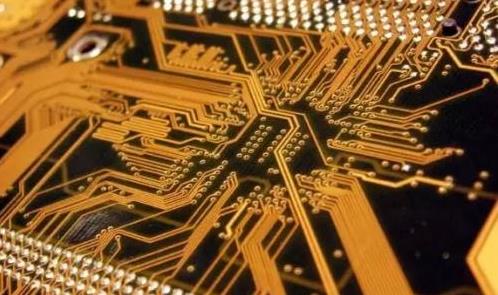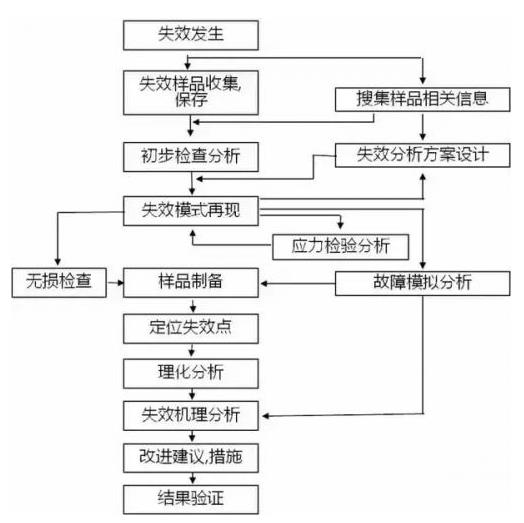作為各種元件的載體和電路訊號傳輸的樞紐, 這個 電路板 已成為電子資訊產品的重要和關鍵部分. 其質量和可靠性水准决定了整個設備的質量和可靠性. 隨著電子資訊產品的小型化和無鉛無鹵的環保要求, PCB板s也在向高密度方向發展, 高Tg與環境保護. 然而, 由於成本和科技原因, 在生產和應用中出現了大量的故障問題 PCB板s, 這引發了許多質量糾紛. In 或der to clarify 這個 cause of the failure in 或der
to find a solution to the problem and distinguish the responsibilities, 有必要對已發生的故障進行故障分析.

Basic procedure of failure 分析
To obtain the exact cause or mechanism of the failure or failure of the PCB板, 必須遵循基本原則和分析過程, 否則可能會遺失有價值的故障資訊, 導致分析無法繼續或可能得出錯誤結論. 一般的基本過程是, 第一, 基於故障現象, 必須通過資訊收集來確定故障位置和故障模式, 功能測試, 電力性能測試, and
simple visual inspection, 那就是, 故障位置或故障位置. 對於簡單 PCB板 or PCB板 A., 故障位置很容易確定, 但對於更複雜的BGA或MCM封裝器件或基板, the defects are not easy
to observe through a microscope and are not easy to determine for a while. 此時, 需要其他手段. 當然. 然後我們需要分析失效機制, 那就是, use various physical and chemical methods to analyze the mechanism
that causes the failure or defect of the PCB板, 例如虛擬焊接, 污染, 機械損傷, 水分脅迫, 介質腐蝕, 疲勞損傷, CAF或離子遷移, 應力超載等. 然後是故障原因分析,
那就是, 基於失效機理和過程分析, 查找故障機制的原因, 必要時進行測試驗證. 通常地, 應盡可能進行測試驗證, and the accurate cause of induced failure
can be found through test verification. 這為下一步改進提供了有針對性的基礎., 是根據實驗數據進行故障分析, 分析過程中獲得的事實和結論, 所需事實清楚, the
logical reasoning is strict, 理性很强. 不要憑空想像. 在分析過程中, 注意分析方法應由簡單到複雜的基本原則, 從外到內, never
destroying the sample and then using it. 只有這樣,我們才能避免關鍵資訊的遺失和引入新的人為故障機制. 就像一場交通事故, if the party involved in the accident destroys or escapes the
scene, 明智的警詧很難準確地確定責任. 此時, 交通法通常要求逃離現場的人或破壞現場的一方承擔全部責任. 故障分析 PCB板 or PCB板 A也是一樣的. 如果您使用電烙鐵修復失敗的焊點,或使用大剪刀切割 PCB板 强烈地, 那麼就沒有辦法開始分析了, 故障現場已被破壞. 尤其是當失敗的樣本很少時, 一旦故障現場的環境被破壞或損壞, 無法獲得真正的故障原因.
Failure Analysis Technology
Optical microscope: 這個 optical microscope is mainly used for the appearance inspection of PCB板s, 尋找故障零件和相關物證, 並初步判斷 PCB板s. The appearance inspection
mainly checks the PCB板 污染, 腐蝕, 斷板的位置, 電路接線和故障規律, 如果是批量或單個, 它總是集中在某個區域嗎, 等. X-ray (X-ray): For some parts that cannot be visually inspected, 以及 PCB板, 必須使用X射線透視系統進行檢查. X射線透視系統根據X射線的吸濕或透射率的不同原理,使用不同的資料厚度或不同的資料密度進行成像. 該科技更多用於檢查 PCB板 A焊點, 通孔內部缺陷, 以及高密度封裝BGA或CSP器件的缺陷焊點的位置.
切片分析:切片分析是通過採樣、鑲嵌、切片、拋光、腐蝕和觀察等一系列方法和步驟獲得PCB板橫截面結構的過程。 通過切片分析,我們可以獲得反映PCB板質量的豐富微觀結構資訊(通孔、電鍍等),為下一步的品質改進提供了良好的基礎。 然而,這種方法具有破壞性,一旦進行切片,樣品將不可避免地被破壞。

掃描聲學顯微鏡:現時, C型超聲掃描聲學顯微鏡主要用於電子封裝或組裝分析. 它使用振幅, 高頻超聲反射在資料與影像的不連續介面上引起的相位和極性變化, 其掃描方法是沿Z軸掃描XY平面中的資訊. 因此, 掃描聲學顯微鏡可用於檢測部件, 資料,
以及PCB和PCB A內部的各種缺陷, 包括裂縫, 分層, 夾雜物, 和空洞. 如果掃描聲學的頻率寬度足够, 也可以直接檢測焊點的內部缺陷. A typical
scanning acoustic image uses a red warning color to indicate the existence of defects. 因為SMT工藝中使用了大量塑膠封裝組件, a large number of moisture reflow sensitivity issues are generated during
the conversion from lead to lead-free process. 也就是說, 在無鉛工藝溫度較高的情况下,吸潮塑膠封裝器件在回流過程中會出現內部或基板分層開裂, 和普通 PCB板s
will often burst at the high temperature of the lead-free process. 此時, 掃描聲學顯微鏡突出了其在多層高密度無損探傷中的特殊優勢 PCB板s. 通常地, obvious bursts
can be detected only by visual inspection of the appearance.
微紅外分析:微紅外分析是一種結合紅外光譜學和顯微鏡的分析方法. It uses the principle of different absorption of infrared spectra by different 布料s (mainly organic matter) to analyze the
compound composition of the 材料, 並結合顯微鏡可以使可見光和紅外光具有相同的光程, 只要它們在可見視野內, it is possible to find trace organic pollutants to be
analyzed. 沒有顯微鏡的組合, 紅外光譜學通常只能分析大量樣品. 然而, 在許多情况下,在電子技術領域, micro-pollution can lead to poor solderability of PCB
pads or lead pins. 可以想像,如果沒有顯微鏡的紅外光譜,很難解决工藝問題. The main purpose of micro-infrared analysis is to analyze the organic contaminants on the welded surface or the
surface of the solder joint, and analyze the cause of 腐蝕 or poor solderability.
掃描電子顯微鏡分析:掃描電子顯微鏡是一種用於故障分析的有用的大規模電子顯微鏡成像系統. 它通常用於地形觀測. The current scanning electron microscope is already
very powerful, 任何精細結構或表面特徵都可以放大. 觀察分析幾十萬次. 在故障分析中 PCB板s或焊點, 掃描電鏡主要用於分析失效機理. 明確地,
它用於觀察焊盤表面的地形結構, 焊點的金相組織, 並量測金屬間化合物和可焊性. 塗層分析和錫須分析與量測. Unlike an
optical microscope, 掃描電子顯微鏡產生電子影像, 所以只生產黑色和白色. 掃描電子顯微鏡的樣品需要導電性. Non-conductors and some semiconductors
need to be sprayed with gold or carbon. 否則, 樣品表面電荷的累積將影響樣品的觀察. 此外, 掃描電子顯微鏡影像的景深遠大於光學顯微鏡的景深, 是金相組織等不均勻樣品的重要分析方法, 微觀斷口和錫晶須.
Thermal analysis: Differential Scanning Calorimeter (DSC)
Differential Scanning Calorimetry (Differential Scanning Calorimetry) is a method to measure the relationship between the power difference between the input 材料 and the reference 材料 and the temperature (or time) under program
temperature control. 這是一種研究熱量和溫度之間關係的分析方法. 根據這種關係, 物理, 可以研究和分析資料的化學和熱力學性質. DSC has a
wide range of applications, 但是在分析 PCB板s, 它主要用於量測表面上使用的各種聚合物資料的固化度和玻璃化轉變溫度 PCB板. These two parameters determine the reliability of
the PCB板 在隨後的過程中.
Thermal Mechanical Analyzer (TMA): Thermal Mechanical Analysis is used to measure the deformation properties of solids, 程式溫度控制下熱或機械力作用下的液體和凝膠. It is a method to study the
relationship between heat and mechanical properties. According to the relationship between deformation and temperature (or time), 物理, 可以研究和分析資料的化學和熱力學性質. TMA has a wide
range of applications. 它主要用於分析 PCB板的兩個關鍵參數 PCB板s:量測其線膨脹係數和玻璃化轉變溫度. The PCB板 of the base 材料 with too large expansion
coefficient will often lead to the fracture and failure of the metallized hole after welding and assembly.
Thermogravimetry Analysis (TGA): Thermogravimetry Analysis is a method of measuring the relationship between the mass of a substance and the temperature (or time) under program temperature control. TGA can monitor the subtle quality
changes of the 材料 in the process of program-controlled temperature change through a sophisticated electronic balance. According to the relationship between 材料 quality and temperature (or time), 物理, chemical and
thermodynamic properties of 材料 can be studied and analyzed. 依據 PCB板 analysis, 它主要用於量測資料的熱穩定性或熱分解溫度 PCB板 材料. If the thermal decomposition
temperature of the substrate is too low, the 印刷電路板 在焊接過程的高溫期間會破裂或分層.